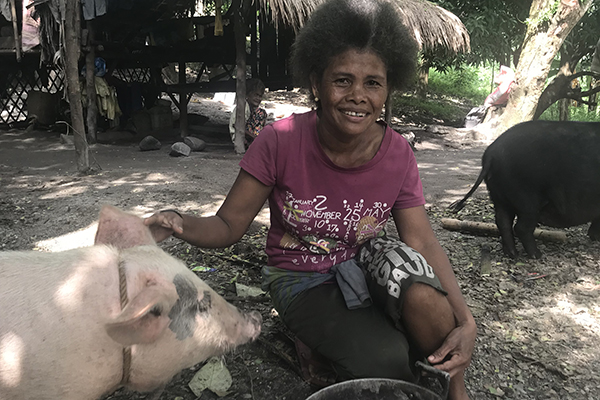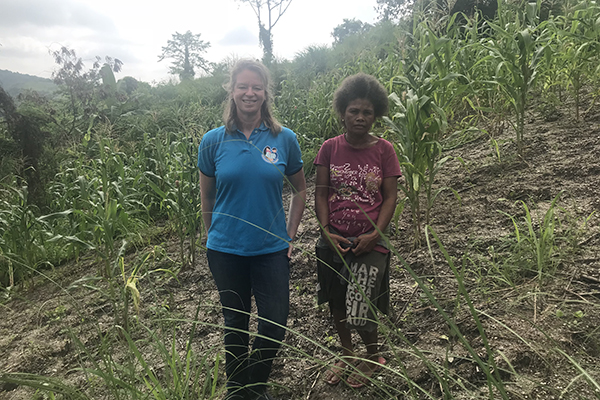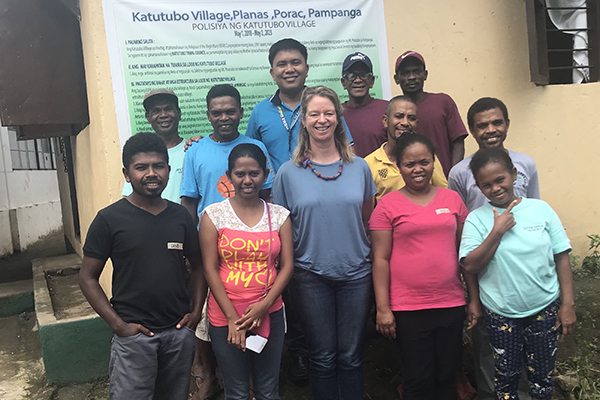Breaking the cycle of extreme poverty

It’s a warm, humid day near the top of a hill in Pampanga, on the Philippine island of Luzon. Nanny Bonna is visibly upset as she recounts the anguish of having her children not attend school.
“All I want for my children is to send them to school,” she says. “We have eyes but cannot even read.”
The importance of an education and what it would mean for her children is not lost on Nanny Bonna. “My children will not be easily fooled. They will know how to read and to even count money,” she says.
Nanny Bonna lives in extreme poverty – defined by The World Bank as someone who lives on less than US$1.90 per day. But according to Opportunity International Australia’s Alex Doyle, the broader definition is multi-dimensional and more about deprivation than income alone.
“Income generation alone does not present an accurate picture of poverty,” she said. “Extreme poverty is measured in terms of deprivations in health, education, housing, food, social security, fuel, sanitation and wellbeing. It’s more about what people are deprived of, than just what income they make."

Social Performance Manager Alex Doyle with Nanny Bonna in the Philippines. Photo: Alex Doyle
To better understand their deprivation, Doyle worked with the community members themselves to identify who were the poorest and determine what their needs were to understand the specific drivers of poverty in the local context.
“We assessed how far they had to walk to access clean water and whether they had a hygienic toilet. We looked at the stability of their shelter; whether it was made from a disposable material or something more solid like brick. We wanted to know how regularly the Extreme Poor were eating and how regularly they were having nutritious meals. Were their children attending school and did they know where to go to seek shelter from the next typhoon?” she says.
But away from the research data, there was something much more personal and profound that struck Doyle after her time amongst the poorest of the poor – “You can see the poverty in their eyes,” she says.
Poverty is an issue of vulnerability. It also leads the UN’s Sustainable Development Goals (SDG’s) with SDG 1 being the eradication of poverty ‘in all its forms’ but specifically, the eradication of ‘extreme poverty’ by 20301.
And while the number of people living in extreme poverty halved between 1990 and 2015 largely due to economic growth, the SDGs state that “too many are still struggling for the most basic human needs.” That number is believed to be approximately 736 million people2.
“Geography can be an important factor to understanding the local context,” Doyle says. “It stands to reason that the closer people live to infrastructure such as roads and industry, the more likely they will get regular work and access government support. Through our work in these communities we zeroed in on extreme poverty in remote areas, particularly women without a second source of income, in particular, Indigenous communities. Extreme poverty exists in all areas, but it’s just more prevalent in remote areas.”
Extreme poverty exists in all areas, but it’s just more prevalent in remote areas.
There is always a question of Government Social Protection (GSP) but GSP only reaches so far due to limited budgets. It is also inconsistent in its coverage because money is spent until it runs out leaving more remote communities cut-off from much-needed support.
The combination of food insecurity, no savings or productive assets, inconsistent work, little to no education, poor health and a lack of hope, creates too much pressure on a family to break the cycle of poverty.
Finding a way to release that pressure and force a chink in extreme poverty’s armour is required.
“In order for them to progress along a pathway out of extreme poverty, we need to work with them across all areas of need to help stabilise their lives, so they don’t get knocked down when the next typhoon comes through their village,” Doyle says.
To do so, Opportunity adopted the ‘Graduation’ approach in a pilot study. The Graduation model was developed by BRAC in Bangladesh in 2002 to establish a comprehensive set of integrated interventions to help extreme poor households achieve sustainable livliehoods3. BRAC has now graduated more than 1,700,000 households out of extreme poverty.

Alex Doyle with members of the tribal council of Katutubo village in the Philippines. Photo: Alex Doyle
With assistance from the Australian Government’s Australian NGO Cooperation Program (ANCP), Opportunity adapted this model for a Filipino context to answer the question: how do we fundamentally shift poverty to have lasting change?
The answer came in the form of gradual behaviour change through working intensively alongside the women to build their confidence, establish an enterprise, and teach them to save.
“Adults either don’t have much education beyond primary school level,” Doyle says. “Therefore, they lack confidence, they are socially excluded and isolated from work, sometimes only being paid in rice. They don’t own land or have electricity; their work is seasonal and intermittent so they don’t have savings and can’t make future plans. There is little knowledge about hygiene or good sanitation and there is a distinct lack of hope.”
We need to graduate people out of their extreme circumstances, that entrenched cyclical circumstance where they just need a leg-up to break that cycle.
“This is achievable by designing programs actively targeting the most vulnerable, increasing basic resources and services and supporting communities lacking in infrastructure and affected by climate-related disasters.”
The Graduation pilot has four pillars: Social Protection – linkages to support services such as health, WASH, Education & Safety Nets; Social Empowerment – promoting social inclusion and behaviour change; Livelihoods Promotion – doing simple business planning and providing productive assets – such as owning a pig or a goat or running a stall; and Financial Inclusion – financial literacy training and mentoring about income management and savings.
At present 890 people in the Philippines have participated in this program. “We found that the strength came from within the communities,” says Doyle. “People formed co-ops to get better prices for their crops at the market and purchased new enterprises, pooling their savings as a group; there was a business planning process for each enterprise – what tools to use, which fertiliser to buy, when to vaccinate the livestock, materials to repair the fishing boat.”
While it is still early days, some promising signs emerged following the initial program. It is important to remember that this is a pre-microfinance pilot and one that is about stabilisation.
“Confidence is the big connector,” Doyle says. “A lack of confidence really is a lack of hope because of the bondage of entrenched poverty where they are vulnerable to future shocks. The ability to take the next step and save for a rainy day (literally) brings a change of mindset and hope for the future.”
“Every component of this program is attached to a Sustainable Development Goal,” Doyle says. “But first and foremost, it aims to end poverty for the poorest.”
References
1. United Nations, Susutainable Development Goals
2. United Nations Development Programme
3. BRAC